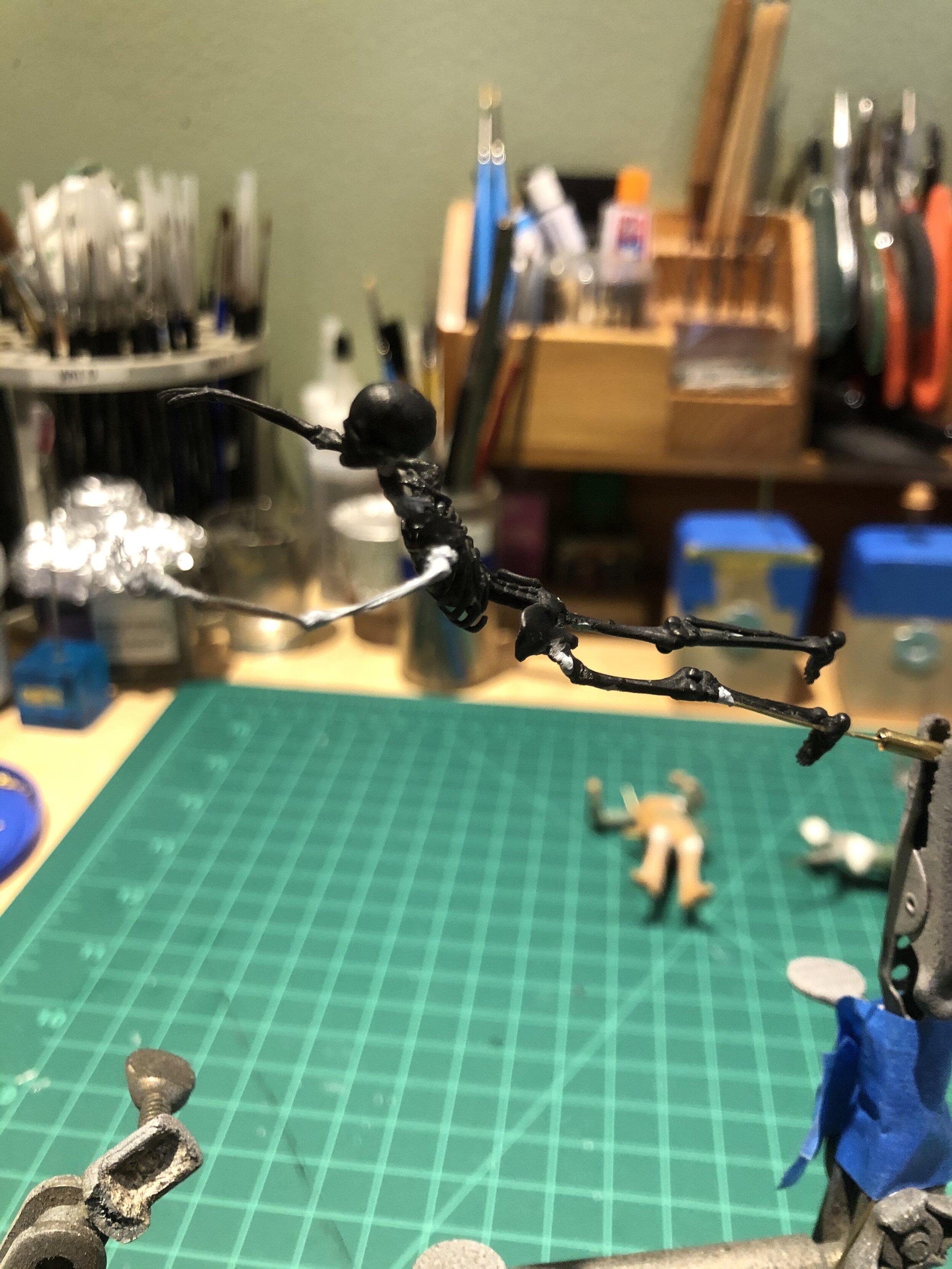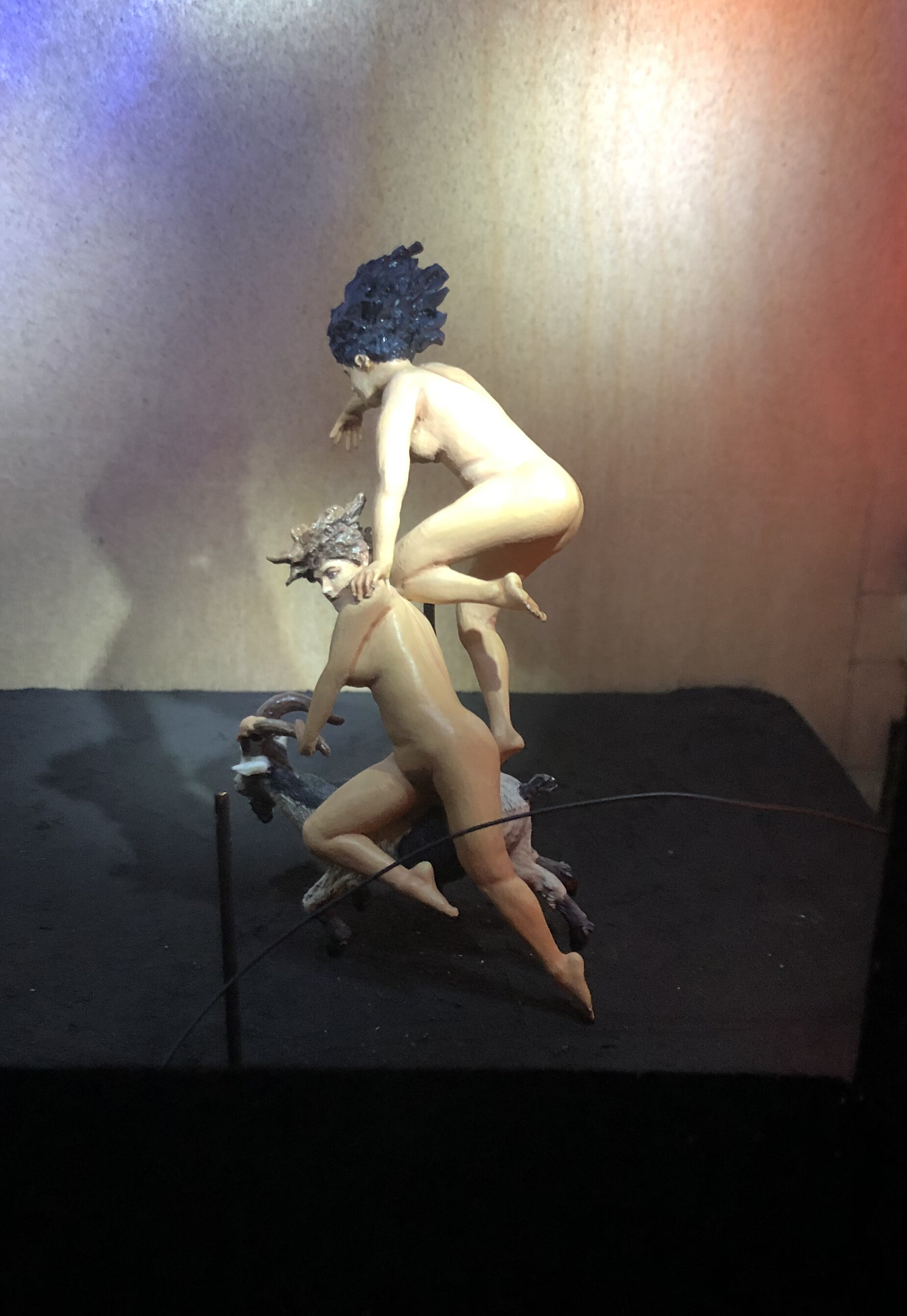Once again, this box diorama started with inspiration from an image I stumbled upon on the Web: “Witches going to their Sabbath (alternate titles “The departure of the witches” and “The Vision of Faust”) by Spanish painter Luis Ricardo Falero (1851–1896), wonderfully creepy in its depiction of Victorian horror and the mysterious powers of strong women. I knew that capturing my version would present plenty of challenges, all of which I welcomed: the complicated, intertwined poses of all of those lush ladies; the tight composition; the illusion of flight; lighting in a moody evening scene; forced perspective for the background figures and bats, and the clouds of mist and mystery.
I took plenty of liberties with the original—gone is that cartoonish lizard; I pared down the number of background figures and creatures; I decided to dress my male victim as a representative of one of the captains of the industrial revolution who were beginning to defile Gaia, and my scene is set later at night—but I otherwise tried to capture the poses as closely as possible, since they were so interesting and such a key part of the painting’s appeal. I used a method suggest by my pal Barry Biediger, printing out the image to scale (1/24th) and positioning my wire skeletons atop it, continually tweaking to bring them in line while looking natural (or as natural as a woman could look while riding a broom through the air) and anatomically correcy. I used some white-styrene Preiser pieces from their Eve set, mostly hands, feet, and heads that I modified pretty extensively (reworking the hair for each, and extensively re-sculpting the face of the crone), but even when I did use the occasional limb, since the Preiser nudes are so athletic in build, a lot of putty (Duro and MagicSculpt) was needed to turn the figures into the more Rubenesque forms of the witches in the painting. The cat, the goat, and the skeleton were all commercial castings from the German company MAiM (Modern Armies in Miniatures), heavily modified, detailed, and converted to fix the posing or to repair the originals; 3D-printed in a weird black material I couldn’t quite identify, they were incredibly brittle and bits and bones kept breaking off! The male is from a styrene figure set by ICM of Henry Ford and some cronies, appropriately enough, and again, it was heavily modified. The lighting was created using my usual methods, with cool blue LEDs and purple, blue, and red theatrical gels and soft-focus filters, but I employed many more mini-spotlights than usual, to make sure I could illuminate and highlight all of the key points of the figures, especially the faces.
I’m proud of the results, and I was very much looking forward to displaying the box at the 2020 Chicago Show, which was to take place not long before Halloween, appropriately enough. Alas, the MMSI had to cancel its annual exhibition this year because of the pandemic and lock-down—a whole other kind of very-real horror that we are all enduring. I hope you can see it at a show “in person” in the future!
Positioning of the figures, all with frequent checks through an approximated viewing window (third from left). The brooms were scratchbuilt with brass rod and fine solder wire. You can see the amount of putty on each figure vs. the styrene forms and my cast-resin torsos and pelvises.
Skeletons are a real challenge, as Shep Paine once told me re: his box diorama “Dr. Syn.” Because the black material kept breaking, the skeleton wound up with a lot more wire and putty than you can see here. In the center, you can see me positioning the primed figures in the unfinished box (with some early lighting testing second from left); at the far right, I’ve begun painting, but even after priming and painting, I was still fixing and repositioning some of the limbs to get the poses right.
After building 16 previous boxes, I am finally getting to be a passable enough carpenter so that everything comes out almost completely square! (Far too many modelers are daunted by the carpentry, but if at first you don’t succeed, just keep trying! Or find a friend who’s more skilled with the table or jig saw.) In the center, you can see the painted figures in position, with the black-velvet-covered back and sides of the inner box; at right, a view of the finished box with the reveal in place, through the viewing window. The forced perspective figures started as 1/32nd scale Preiser Eve figures, modified as extensively as the 1/24th or 75mm figures in the foreground. I sculpted the bats over wire and lead foil. The ground is Celluclay over balsa foam (easier to position, re-position, and re-re-position the hidden support rods) with some scale model railroad trees. Very little of the ground (which is sloped upward and angled inward to enhance the forced perspective) is visible in the end, concealed by the lighting or the clouds of fiber polyfill (the kind sold for stuffing pillows) that I used for the “mist.” Below: A look at the mini-spotlights concealed on the back of the reveal, and a shot of the finished inner box, minus only the black-velvet “ceiling” of the scene.












